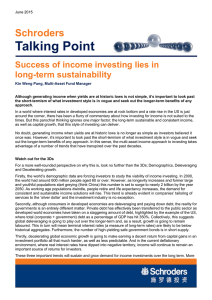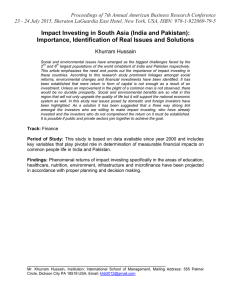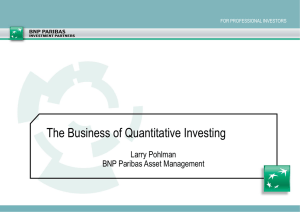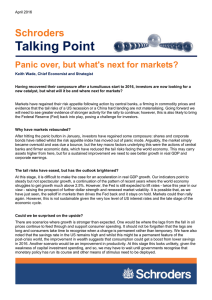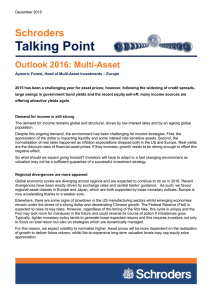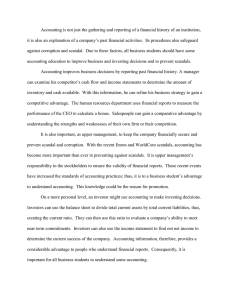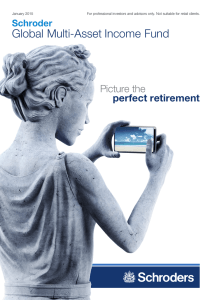Talking Point Schroders Success of income investing lies in long-term sustainability
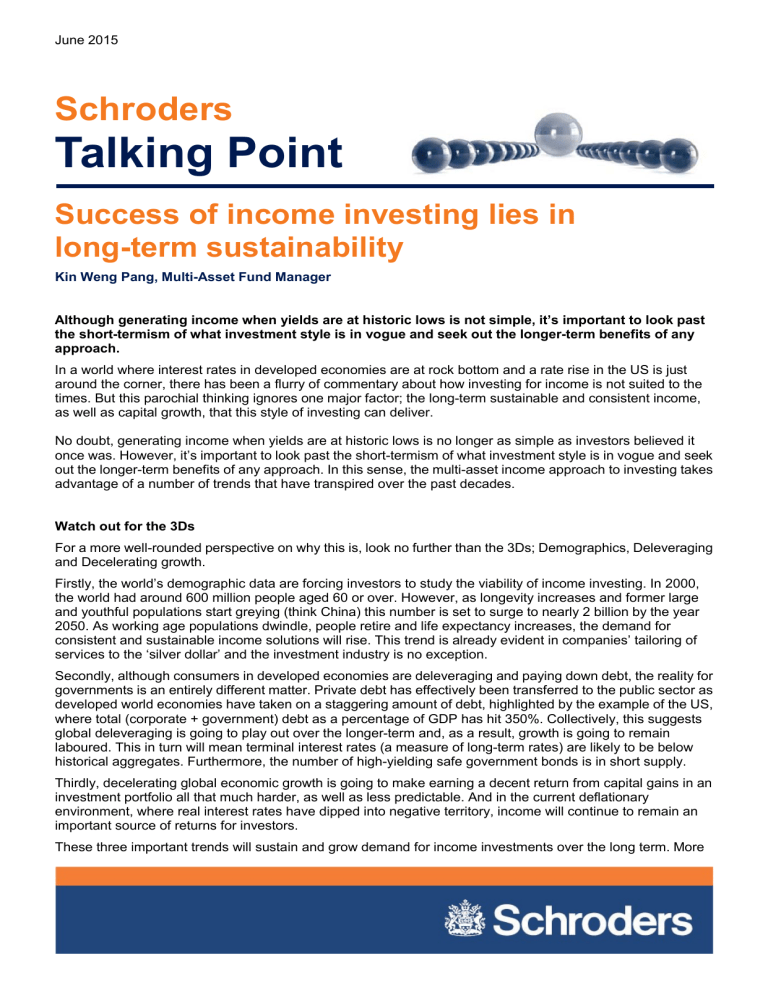
June 2015
Schroders
Talking Point
Success of income investing lies in long-term sustainability
Kin Weng Pang, Multi-Asset Fund Manager
Although generating income when yields are at historic lows is not simple, it’s important to look past the short-termism of what investment style is in vogue and seek out the longer-term benefits of any approach.
In a world where interest rates in developed economies are at rock bottom and a rate rise in the US is just around the corner, there has been a flurry of commentary about how investing for income is not suited to the times. But this parochial thinking ignores one major factor; the long-term sustainable and consistent income, as well as capital growth, that this style of investing can deliver.
No doubt, generating income when yields are at historic lows is no longer as simple as investors believed it once was. However, it’s important to look past the short-termism of what investment style is in vogue and seek out the longer-term benefits of any approach. In this sense, the multi-asset income approach to investing takes advantage of a number of trends that have transpired over the past decades.
Watch out for the 3Ds
For a more well-rounded perspective on why this is, look no further than the 3Ds; Demographics, Deleveraging and Decelerating growth.
Firstly, the world’s demographic data are forcing investors to study the viability of income investing. In 2000, the world had around 600 million people aged 60 or over. However, as longevity increases and former large and youthful populations start greying (think China) this number is set to surge to nearly 2 billion by the year
2050. As working age populations dwindle, people retire and life expectancy increases, the demand for consistent and sustainable income solutions will rise. This trend is already evident in companies’ tailoring of services to the ‘silver dollar’ and the investment industry is no exception.
Secondly, although consumers in developed economies are deleveraging and paying down debt, the reality for governments is an entirely different matter. Private debt has effectively been transferred to the public sector as developed world economies have taken on a staggering amount of debt, highlighted by the example of the US, where total (corporate + government) debt as a percentage of GDP has hit 350%. Collectively, this suggests global deleveraging is going to play out over the longer-term and, as a result, growth is going to remain laboured. This in turn will mean terminal interest rates (a measure of long-term rates) are likely to be below historical aggregates. Furthermore, the number of high-yielding safe government bonds is in short supply.
Thirdly, decelerating global economic growth is going to make earning a decent return from capital gains in an investment portfolio all that much harder, as well as less predictable. And in the current deflationary environment, where real interest rates have dipped into negative territory, income will continue to remain an important source of returns for investors.
These three important trends will sustain and grow demand for income investments over the long term. More
Schroders Talking Point Page 2 crucially, these 3Ds are structural shifts that will endure and will therefore require long-term planning in both sustaining income as well as growing capital in investors’ portfolios.
Achieving income
So how best can investors achieve income while minimising risk? In 2007, holding cash that would yield 5% would have been good enough. A typical approach nowadays here in Asia is to focus on a split between Asian high-yield bonds and Asian dividend stocks. However, the yield on offer is not commensurate with the volatility that has been present. With a multi-asset approach, a similar yield is achieved with just under half the level of volatility. The two aforementioned asset classes, along with REITs, global equities and fixed income, and emerging market debt (EMD) mean wider diversification risk as well as sources of income.
It also demonstrates the benefits of the need to be unconstrained in your investment approach and how imperative it is to focus on higher quality securities that will grow and sustain income returns. Although the phrase ‘currency wars’ may be hyperbole at this point, there is no denying that currency fluctuations have eroded many markets’ headline returns (with foreign investors in Japan suffering on the yen’s weakness). In contrast, a multi-asset approach to investing allows for active asset allocation that manages risks in all the different asset classes.
Income is still the outcome
Although the merits of a multi-asset approach to income investing are clear over the longer-term, how will this style of investing fare in an environment where the Federal Reserve (Fed) is likely to raise rates in the current year and beyond? The key factor we look at, as multi-asset income investors, is how fast the Fed will raise rates. And the current fragility of a full-blown recovery in the US economy suggests that rate rises, when they do occur, will be implemented gradually.
History suggests that high dividend stocks and high-yield bonds actually delivered solid performance in the last tightening cycle by the Fed in 2004-2007. Bonds may be hit the hardest by a rate rise but this should be offset somewhat by a likely cap on yields, which will still allow for opportunities to arise. However, the larger picture still supports the case for income. Although the world is focused on the tightening timetable in the US, the rest of the world is easing policy. This is true of both Europe and Japan but also Asia, where central banks from
India to Korea are cutting interest rates.
In a low growth and low interest rate world, where the appetite for income is only growing, sustainable income investing, and the flexibility that accompanies it, will ensure it remains an important source of returns for years to come.
Important Information
Any security(s) mentioned above is for illustrative purpose only, not a recommendation to invest or divest.
This document is intended to be for information purposes only and it is not intended as promotional material in any respect. The views and opinions contained herein are those of the author(s), and do not necessarily represent views expressed or reflected in other Schroders communications, strategies or funds. The material is not intended to provide, and should not be relied on for investment advice or recommendation. Opinions stated are matters of judgment, which may change. Information herein is believed to be reliable, but Schroder Investment Management (Hong Kong) Limited does not warrant its completeness or accuracy.
Investment involves risks. Past performance and any forecasts are not necessarily a guide to future or likely performance. You should remember that the value of investments can go down as well as up and is not guaranteed. Exchange rate changes may cause the value of the overseas investments to rise or fall. For risks associated with investment in securities in emerging and less developed markets, please refer to the relevant offering document.
The information contained in this document is provided for information purpose only and does not constitute any solicitation and offering of investment products. Potential investors should be aware that such investments involve market risk and should be
Schroders Talking Point Page 3 regarded as long-term investments.
Derivatives carry a high degree of risk and should only be considered by sophisticated investors.
This material, including the website, has not been reviewed by the SFC. Issued by Schroder Investment Management (Hong
Kong) Limited.
Schroder Investment Management (Hong Kong) Limited
Level 33, Two Pacific Place, 88 Queensway, Hong Kong
Telephone +852 2521 1633 Fax +852 2530 9095
